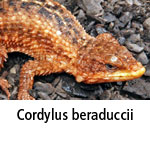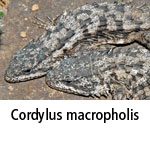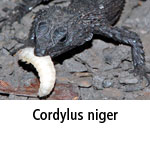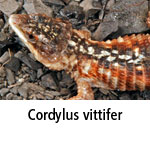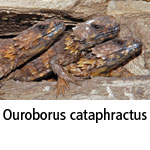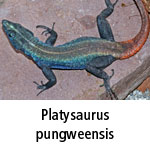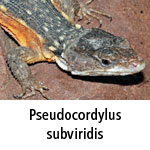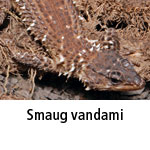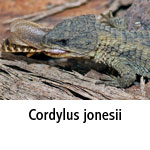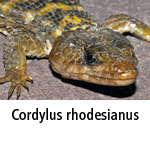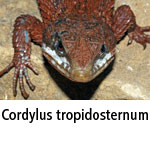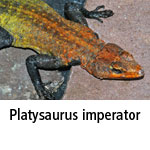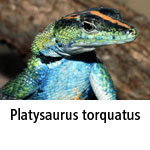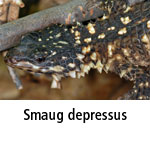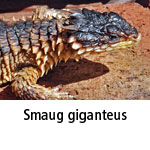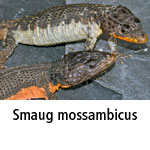
Cordylidae – Girdled Lizards
The Cordylidae, the so-called girdled lizards and their relatives, include more than 50 species of small to medium size, all native to the countries of southern Africa. After a revision of the family in 2011 these were split into a number of well-known (Cordylus, Platysaurus, Pseudocordylus) and new genera. Except Platysaurus all genera are viviparous.
Most species are soil or rock dwellers, many of them show very interesting characteristics, some even a colourful appearance, but are all relatively shy. Some species are quite difficult to breed, for example Smaug giganteus because their natural environment and thus living conditions are difficult to imitate, at least in the indoor terrarium. As pets and study objects the Cordylidae are highly interesting, one reason is their long lifespan.
After years of waiting an up-to-date book on cordylids was thrown on the market in 2014, unfortunately the aspects of keeping and breeding are treated very poorly and inexcusably incomplete. Some specialist journal articles of the past 20 years provide more specific information. It's still worth the purchase because of the good pictures and the latest overview of the majority of the family – unfortunately the genus Platysaurus is not covered.
Most species are soil or rock dwellers, many of them show very interesting characteristics, some even a colourful appearance, but are all relatively shy. Some species are quite difficult to breed, for example Smaug giganteus because their natural environment and thus living conditions are difficult to imitate, at least in the indoor terrarium. As pets and study objects the Cordylidae are highly interesting, one reason is their long lifespan.
After years of waiting an up-to-date book on cordylids was thrown on the market in 2014, unfortunately the aspects of keeping and breeding are treated very poorly and inexcusably incomplete. Some specialist journal articles of the past 20 years provide more specific information. It's still worth the purchase because of the good pictures and the latest overview of the majority of the family – unfortunately the genus Platysaurus is not covered.
Cordylidae – Gürtelschweife
Zu den Cordylidae, den Gürtelschweifen oder Wirtelschweifen, gehören über 50 Arten kleiner bis mittlerer Größe, sämtlich im südlichen Afrika beheimatet. Nach einer Revision der Familie im Jahre 2011 wurden diese in eine Reihe bekannter (Cordylus, Platysaurus, Pseudocordylus) und neuer Gattungen aufgespalten. Außer Platysaurus sind alle Gattungen lebendgebärend.
Die meisten Arten sind Boden- bzw. Felsbewohner, viele zeigen ein sehr interessantes Verhalten, zudem oft eine bunte Zeichnung, sind aber sämtlich relativ scheu. Einige Arten sind zudem nur schwierig zu züchten, zum Beispiel Smaug giganteus, weil die Lebensbedingungen zumindest im Zimmerterrarium nur schwer nachzuahmen sind. Als Terrarientiere sind die Cordylidae hoch interessant, schon weil sie sehr ausdauernde Pfleglinge sind.
Seit 2014 gibt es nach langer Ankündigung zwar endlich ein aktuelles Buch zu Gürtelschweifen, leider wurde der Aspekt Haltung und Zucht äußerst stiefmütterlich und sträflich lückenhaft behandelt. Einige Zeitschriftenartikel der letzten 20 Jahre bieten mehr spezifische Informationen. Dennoch lohnt die Anschaffung wegen der guten Fotos und des aktuellen Überblicks über den Großteil der Familie – die Gattung Platysaurus wird nicht behandelt.
Die meisten Arten sind Boden- bzw. Felsbewohner, viele zeigen ein sehr interessantes Verhalten, zudem oft eine bunte Zeichnung, sind aber sämtlich relativ scheu. Einige Arten sind zudem nur schwierig zu züchten, zum Beispiel Smaug giganteus, weil die Lebensbedingungen zumindest im Zimmerterrarium nur schwer nachzuahmen sind. Als Terrarientiere sind die Cordylidae hoch interessant, schon weil sie sehr ausdauernde Pfleglinge sind.
Seit 2014 gibt es nach langer Ankündigung zwar endlich ein aktuelles Buch zu Gürtelschweifen, leider wurde der Aspekt Haltung und Zucht äußerst stiefmütterlich und sträflich lückenhaft behandelt. Einige Zeitschriftenartikel der letzten 20 Jahre bieten mehr spezifische Informationen. Dennoch lohnt die Anschaffung wegen der guten Fotos und des aktuellen Überblicks über den Großteil der Familie – die Gattung Platysaurus wird nicht behandelt.
Literatur
Stanley, Edward L.; Aaron M. Bauer; Todd R. Jackman, William R. Branch, P. Le Fras N. Mouton (2011). Between a rock and a hard polytomy: rapid radiation in the rupicolous girdled lizard (Squamata: Cordylidae). Molecular Phylogenetics and Evolution, 58(1): 53–70.
Reissig, Jens (2014). Gürtelschweife. Biologie, Haltung und Zucht. Chimaira, Frankfurt am Main.
Reissig, Jens (2014). Girdled Lizards and their relatives. Natural History, Captive Care and Breeding. Chimaira, Frankfurt am Main.
Stanley, Edward L.; Aaron M. Bauer; Todd R. Jackman, William R. Branch, P. Le Fras N. Mouton (2011). Between a rock and a hard polytomy: rapid radiation in the rupicolous girdled lizard (Squamata: Cordylidae). Molecular Phylogenetics and Evolution, 58(1): 53–70.
Reissig, Jens (2014). Gürtelschweife. Biologie, Haltung und Zucht. Chimaira, Frankfurt am Main.
Reissig, Jens (2014). Girdled Lizards and their relatives. Natural History, Captive Care and Breeding. Chimaira, Frankfurt am Main.
Under preparation • In Vorbereitung
